Analysis
12 Questions the Art Market Should Have About CryptoPunks, the NFT Avatars Set to Sell for Millions at Christie’s, Answered by an Actual Expert
The nine Punks are being sold as one lot.
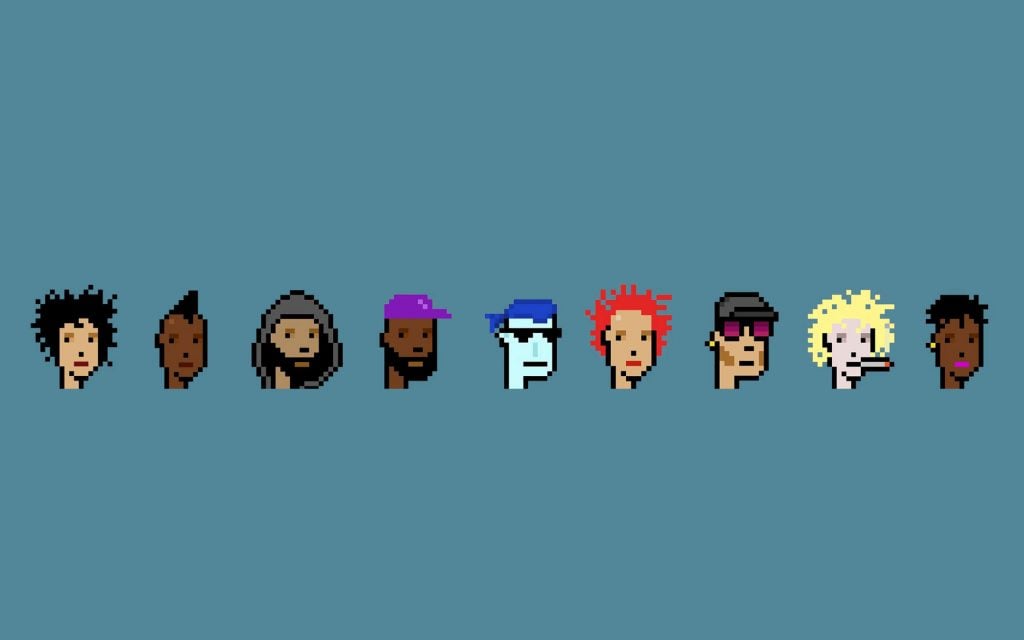
The nine Punks are being sold as one lot.

Amy Castor

This week, CryptoPunks are the talk of the town.
Christie’s is auctioning off a single lot of NFTs, or non-fungible tokens, representing a collection of nine CryptoPunks at its 21st century evening sale on May 13 in New York. The auction house expects the lot to go for between $7 million and $9 million, either in actual dollars or cryptocurrency—though, let’s be honest, most likely it will sell for cryptocurrency.
The simple pixel faces corresponding to these NFTs don’t look like high art by any stretch. Yet, here they are, selling alongside major works by Monet, Picasso, and Basquiat. Are Punks a new form of blue-chip art? Are they collectibles? Or are they simply a way to lure more money into cryptocurrencies?
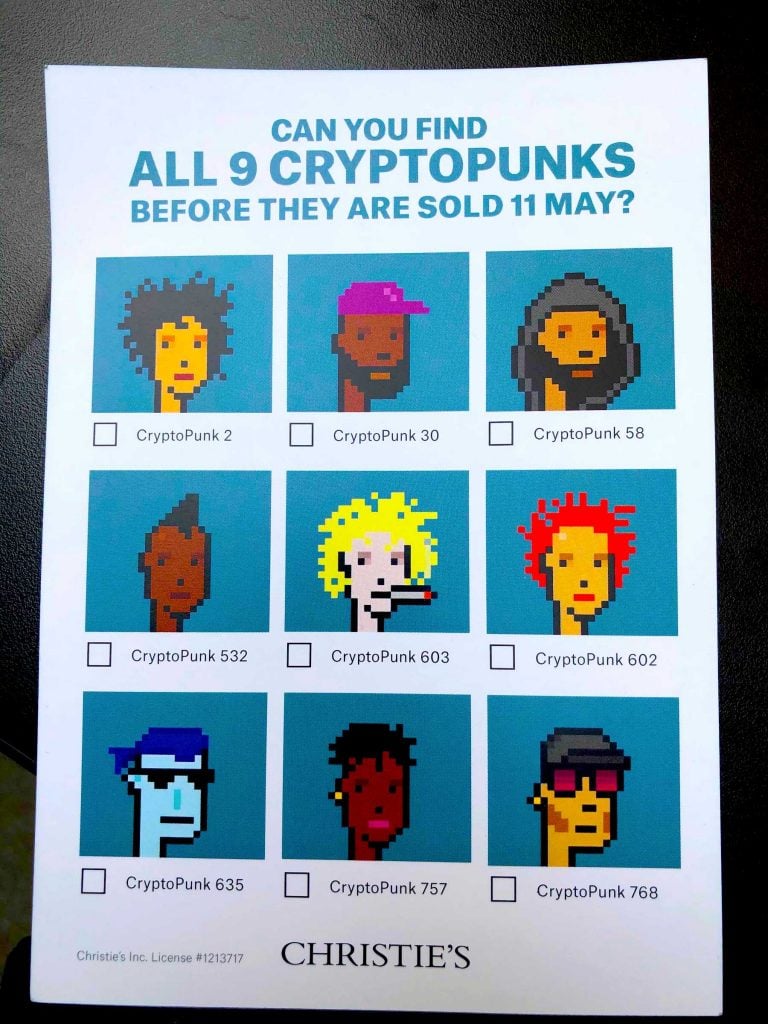
Flyer as part of Christie’s promotional campaign for its sale of nine CryptoPunks. Photo by Katya Kazakina.
All we can tell you for certain is that Punks are “the thing” right now. Since the beginning of the year, some have sold for millions of dollars while others have sold for tens of thousands of dollars in crypto, depending on how rare or unusual they are. (We’ll get to how that is defined below.) They are consistently at the top of the rankings of the most hotly traded classes of NFTs.
Christie’s has played an important role, of late, in popularizing NFTs both to the art world and beyond, so the auction of these digital collectables is a major moment in their life as cultural artifacts.
But why are CryptoPunks fetching millions of dollars in crypto in the first place? The short answer, of course, is because that’s what folks (mainly crypto insiders) are willing to pay for them—and the recent crypto bubble has left some crypto whales flush with bitcoin and ether, the native crypto of the Ethereum blockchain, which is where most NFTs, like CryptoPunks, are stored.
Here are answers to your most pressing questions about CryptoPunks—as well as some of the questions we think you should be asking.
Basically, they are 8-bit computer-generated avatars, represented by NFTs that live on the Ethereum blockchain. Every Punk is different. No two are alike.

Matt Hall and John Watkinson at TechCrunch Disrupt New York, May 2011. (Photo by Charles Eshelman/Getty Images for AOL)
Two Canadian bitcoiners, Matt Hall and John Watkinson, created CryptoPunks out of their New-York-based company Larva Labs in June 2017. They imagined something akin to trading collectibles, like sports cards, but on the blockchain.
The pair had been fiddling with an avatar generator used to create assets for games. Eventually, they came up with an algorithm as the basis for combining 24×24 pixel portraits with a slew of accessories such as hats, beards, hair, lipstick, and even buck teeth to make each Punk unique.
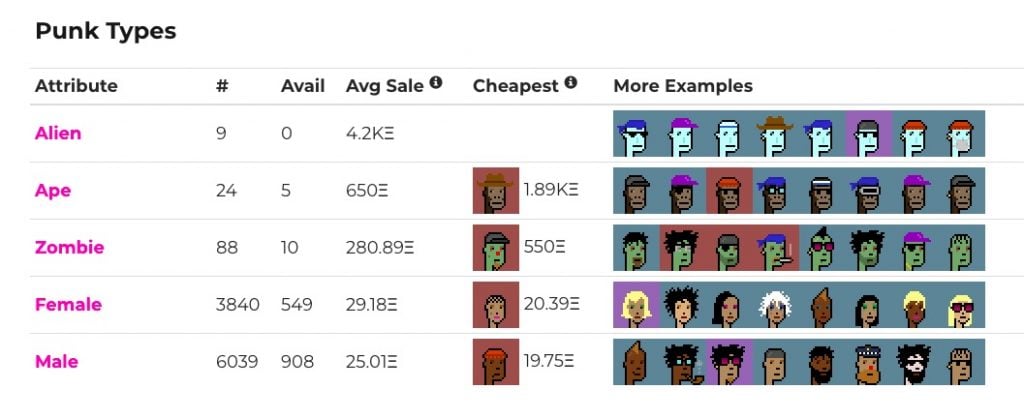
Screenshot of the “Punk Types” page of Larva Labs.
They offered up 9,000 of these Punks for free. All you needed to get your hands on one was an Ethereum wallet and enough ether to cover the transaction, or “gas,” fee, which was pennies at the time. (It’s currently $13, and was as high as $40 in February.)
At first, only a handful of CryptoPunks were claimed, but after a story ran in Mashable, the rest were snatched up in a matter of hours.
(Incidentally, Larva Labs has just announced a follow up to CryptoPunks: Meebits, a slightly more polished, 3D spin on the unique pixelated character idea. They aren’t quite as rare as CryptoPunks, given that there are 20,000 of them, but they have already attracted a lot of attention. They sold out in three hours, netting Larva Labs $80 million—in crypto. The following day, a meebit sold for $1.4 million in crypto.)
Yes, they kept 1,000 of the 10,000 unique CryptoPunks. (A digital wallet belonging to the platform’s creators still holds some 440 punks.) The nine Punks that they are selling at Christie’s are from their own private collection, meaning they will personally pocket the millions that come from the sale. Their only equity in the project is in the punks they own, the pair told Techcrunch. They don’t take a cut on sales.
Well, yes—but not right away. Initially, most Punks sold for the equivalent of just a few dollars in ether. As time went on, they started to go up in value, but not by much. Every now and then, one would sell for over $100 in ether. Back in 2017, a rare variety of Punk, like a knitted-cap wearing alien, went for over $2,000. It wasn’t until very recently that Punks started trading for eye-popping amounts of ether.
To date, the CryptoPunks platform has seen more than $300 million worth of cryptocurrency in sales, according to CryptoSlam, a site that monitors NFTs. But bidders should know that the vast majority of big-money trades has occurred only in the past few months.
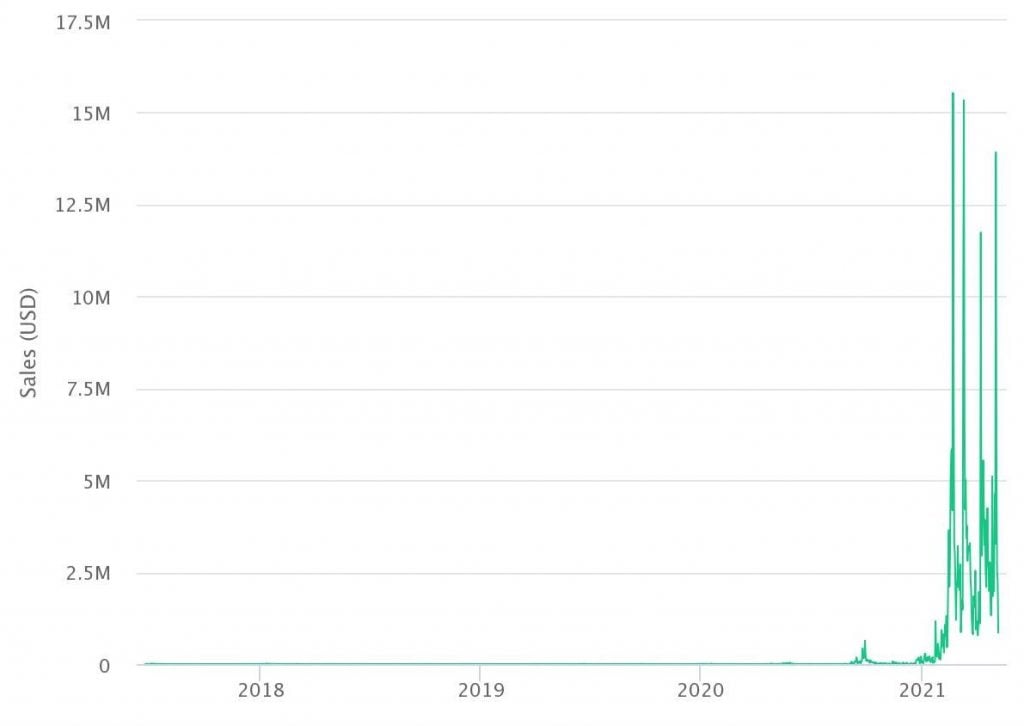
Chart showing the value of CryptoPunks over time from CryptoSlam.
NFTs started to pump in September, as 2020’s so-called “DeFi summer” began to cool down. DeFi, or decentralized finance, refers to specialized apps on Ethereum that facilitate lending, borrowing, and trading. Starting in June, a lot of money began piling into the space, leading to a huge increase in the value of DeFi tokens, and a new wave of crypto nouveau riche.
Cashing out of large sums of crypto is not always easy, so many funneled their winnings into other digital assets, including NFTs.
Today, the cheapest Punk goes for around $70,000 in cryptocurrency. Back in January, you could have easily bought one for a few thousand dollars.
CryptoPunks launched just as the last crypto bubble was heating up. In 2017, the price of bitcoin climbed from $1,000 in January to nearly $20,000 by the end of the year.
In the same time frame, ether—the cryptocurrency that Punks are widely bought and sold for—climbed from $7 to nearly $800. (Ether is currently over $3,300, to give you a sense of how big this current bubble is.)
A white-hot initial coin offering market helped fuel the 2017 crypto boom—that is, various startups were minting their own tokens on the Ethereum blockchain and selling those to raise funds, generally in the form of cryptocurrency, for their projects. An estimated $4.9 billion was raised by ICOs in 2017. Many of those projects have since faded into obscurity, after ICOs fell out of fashion—and the SEC began prosecuting several promoters for selling unregistered securities.
In a very similar way, the get-rich-quick rhetoric around NFTs is helping to shape the current explosion of crypto prices.
On February 18, Punk #4156, an ape with a blue bandana, sold for $1.25 million in ether. The following day, Punk #6965, an ape with a fedora, sold for $1.54 million in ether.
Record prices for Punks went even higher in March. Just before Christie’s closed the bidding on Beeple’s notorious NFT in March, two rare blue-skinned alien Punks—Punk #7804 and Punk #3100—sold separately for $7.5 million each worth of ether.
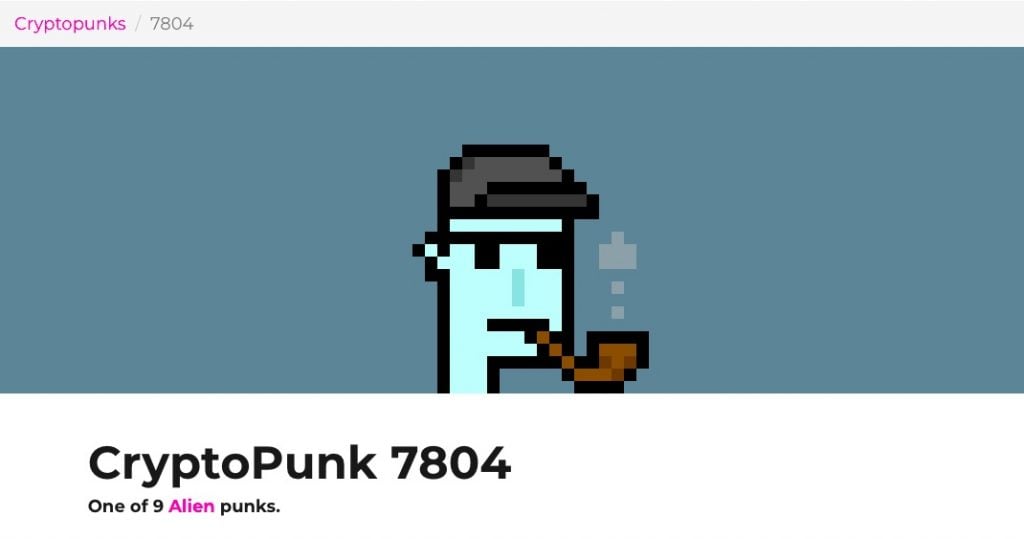
Screenshot of CryptoPunk 7804 from the Larva Labs site.
(It’s important to note that because we don’t always know who the buyers are in NFT sales, it’s hard to determine if all of the sales are real. Someone could, for instance, easily buy a Punk from themselves to make it look like a Punk is in high demand. Wash trading, a type of market manipulation where the same person does the buying and selling, is not uncommon in crypto markets. Even Coinbase, a regulated crypto exchange, now publicly traded, was recently accused of it.)
Hall and Watkinson claim that their CryptoPunk project was an experiment in scarcity and demand—the idea being that some Punks would trade for more based on how rare they are.
Punks were computer-generated based on templates. There are 3,840 females and 6,039 males, along with 9 aliens, 24 apes, and 88 zombies. Accessories or attributes, used to dress up Punks, made some more special than others.
Only 44 have beanies, 48 wear a choker, and 54 have pilot helmets. Eight have no accessories, while only one has seven accessories. But what garners more money is not always based on rarity alone. There’s a bit of unpredictability to the market, with some attributes gaining popularity for no apparent reason. Right now, “hoodies are the bomb,” a user named VRPunk told me in the CryptoPunk Discord channel.
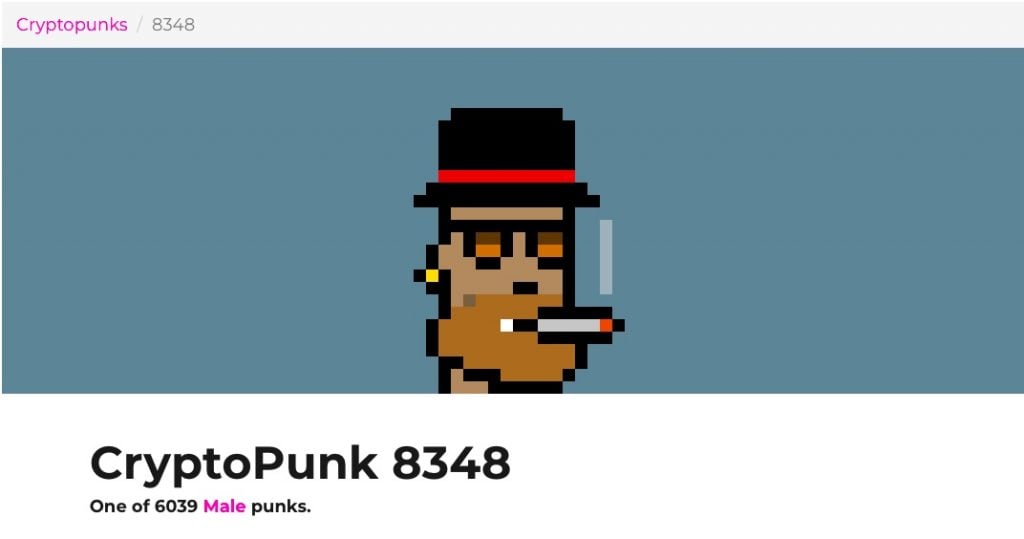
Screenshot of CryptoPunk 7804 from the Larva Labs site.
Even though there are fewer female Punks, they also trade for higher values. And females have unique attributes, like certain hairstyles, welding goggles, and pilot helmets.
Each Punk also comes with a number (0 to 9,999) depending on when it was minted. For some reason, people value the lower numbers more, but there is really no rhyme or reason to any of this, because all were minted simultaneously.
Christie’s and Larva Labs are promoting the nine Punk NFTs up for grabs next week in terms of how remarkable they are compared to, say, the other 9,991 other Punks in existence, or a random avatar on the Internet, or pixel art you create at home.
All nine (Punks 2, 532, 58, 30, 635, 602, 768, 603, 757) have mint numbers under 1,000. Punk 635 is one of only nine alien Punks. There is also a 2 Punk, a female with wild hair, and those lower numbers can go for higher amounts. CryptoPunk 532 has a mohawk; Punk 58 has a black beard. Other features in the mix include muttonchops, earrings, and big shades. But overall, there is nothing really special about the others—other than that they have a good mix of skin tones and accessories.
As with other NFTs, the CryptoPunk art is not actually stored on the blockchain. What you are buying is a number in a database and a pointer to an image stored elsewhere on the internet, that is all.
What is stored on the blockchain is a cryptographic hash of a composite image with all of the Punks in it—not your individual Punk, but all of the Punks. (The hash is simply a way of checking that an image stored on a server is an exact duplicate of the one corresponding to your NFT, but in this case, it is a composite.)
Since #CryptoPunks are mooning hard, here is the @IPFS mirror of the punks image (thanks to @IPFSPinata): https://t.co/DdoekdMaLt pic.twitter.com/9zmPj9cKAO
— Pixls (@pixls_dot_eth) September 11, 2020
Anyone can view your Punk, displayed on a special webpage, and the blockchain tracks how many times a Punk has changed hands. Owning the NFT, in and of itself, does not guarantee ownership of the underlying art.
Hidden in its 33-page conditions of sale document, Christie’s admits that you are only buying the NFT, not the art:
Your purchase of the lot does not provide any rights, express or implied, in (including, without limitation, any copyrights or other intellectual property rights in and to) the digital asset underlying the NFT other than the right to use, copy, and display the digital asset for your own personal, non-commercial use or in connection with a proposed sale or transfer of the NFT and any other right expressly contained in these Conditions of Sale.
That art can be copied. In fact, Binance, an offshore crypto exchange, copied all of the CryptoPunk artwork and created its own NFT marketplace for CryptoPunks. Instead of buying Punks with ether, you buy them with BNB, Binance’s own coin. (The CryptoPunks project is open source and available on Github, so it’s fair game for anyone to use the code for their own project.)
CryptoPunks get points for being the first NFTs as we know them. Hall and Watkinson maintain that CryptoPunks were the earliest NFT project on Ethereum and an inspiration for ERC-721, the Ethereum standard that most NFTs are based on today. The community has an active Discord channel, where Punk enthusiasts talk about trading and discuss coveted accessories.
(The group is not particularly receptive to outsiders, incidentally, with one user calling me a “salty old lady” after I posted questions there for this article. They seemed to get particularly stirred up when I asked why male punks were more numerous than females. The attacks continued on Twitter.)
In truth, NFT-type tokens existed before CryptoPunks.
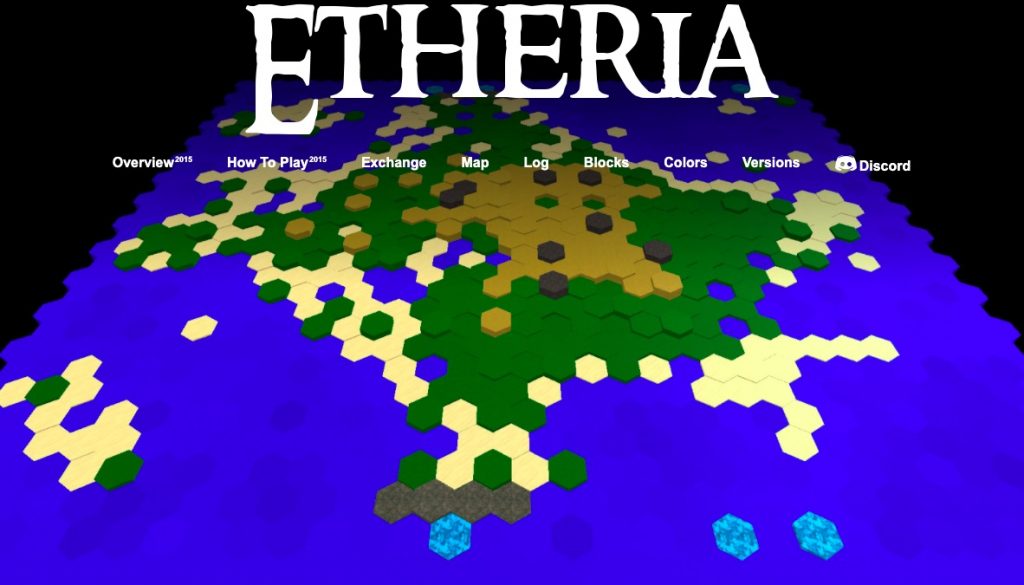
Screenshot of the landing page for ‘Etheria.’
Etheria, which came out in October 2015, three months after Ethereum launched its mainnet, claims to be the earliest NFT project. Etheria is a virtual world composed of hexagonal tiles that can be bought, sold, and built on as NFTs. The project lay dormant for years and most of Etheria’s 457 tiles went unsold until a renewed interest in NFTs sparked a buying frenzy.
Prior to CryptoPunks, so-called “rare Pepes,” the alt-right associated drawings of Pepe the Frog, also traded on Ethereum starting in April 2016 via an app called Peperium. (Previously, Rare Pepes traded on Counterparty, an early NFT platform, built on top of the bitcoin blockchain.)
Well, this week’s Christie’s sale is a live auction, unlike the Beeple auction, which was all online. You can place a bid at the event or via Christie’s online bidding platform “Christie’s Live,” which allows you to see the bidding floor in real time. (See Christie’s guide to bidding.)
Otherwise, if you are flush with ether and want to own a CryptoPunk, you can go directly to the CryptoPunk website where anyone can buy, sell, and bid on the avatars.
First, though, you’ll need an Ethereum wallet, probably Metamask, a Chrome browser extension. And you need some ether—lots of it. If you need more, Metamask allows you to buy some directly from Coinbase.
Once you have Metamask installed, pick out a Punk that appeals to you, and make a bid. If the owner accepts your bid, congratulations! You are now the proud owner of a CryptoPunk.
Starting in the third quarter of 2020, a new app called Wrapped Punks, which effectively turns Punks into an ERC721 token, allows you to list CryptoPunks on specialized NFT marketplaces such as OpenSea and Rarible. (This even correlated to higher bids on Punks, starting in September.)
What seems to have triggered this latest wave of activity is the "Wrapped Cryptopunks" contract by @arkgalleryDAO which allows owners to officially list their punks on markets like @opensea and @rariblecom for the first time. 1/
— Larva Labs (@larvalabs) September 15, 2020
Good question. As a crypto journalist, I can tell you a lot of the market is governed by the idea of “pump and dump”: bidding up the price to create hype that lures in naive investors, then leaving them holding the bag. To me, the hype around CryptoPunks fits more with this pattern than it does collectors investing long-term. The Christie’s sale is huge marketing coup for the flippers.
Bubbles have a tendency to burst. We’re already seeing signs that the excitement over NFTs is starting to wane. In short: It’s probably not a good idea to spend any more than you can afford to lose.
Amy Castor is a freelance writer from Boston who specializes in cryptocurrency and financial fraud. She is currently writing a book on NFTs. You can follow her on Twitter at @ahcastor.